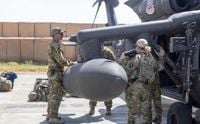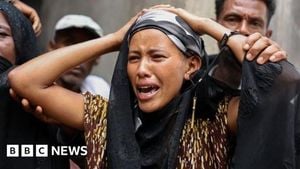The United States is entering a new chapter in its two-decade military involvement in Iraq, as the Pentagon confirmed this week that it has begun a major drawdown of its forces in the country. This reduction, which follows a 2024 agreement with the Iraqi government, marks a significant transition in the American-led coalition’s campaign against the Islamic State group (ISIS or Daesh) and signals a shift in the broader U.S. military strategy across the region.
According to Reuters, the Pentagon recommitted on Tuesday, October 1, 2025, to scaling back its mission in Iraq. The plan, which has been months in the making, will see the number of U.S. troops in Iraq fall from approximately 2,500 at the start of 2025 to fewer than 2,000. Most of the remaining personnel will be stationed at a base in Erbil, in the semi-autonomous Kurdistan region of northern Iraq. The U.S. presence in Baghdad will be limited to a small group of advisers focused on bilateral security cooperation rather than direct counter-ISIS operations.
The drawdown is the result of a September 2024 agreement between Washington and Baghdad, as reported by The Washington Post. Pentagon spokesman Sean Parnell explained, “The United States and coalition partners will reduce their military mission in Iraq. This reduction reflects our combined success in fighting ISIS and marks an effort to transition to a lasting U.S.-Iraq security partnership.” He added that the U.S. would maintain close coordination with the Iraqi government and coalition members throughout the process.
The withdrawal is already underway, with U.S. troops departing from several bases, including the Ain al-Asad airbase in western Anbar province. A senior Iraqi security official, speaking anonymously, confirmed to Reuters that withdrawals have begun in both Baghdad and Ain al-Asad. The transition is structured in two phases: the first, to be completed by September 2025, will see the end of coalition military operations against ISIS and the closure of long-standing U.S. bases. The second phase, extending into 2026, will allow the U.S. to continue supporting counter-ISIS efforts in neighboring Syria from positions inside Iraq.
This shift is not just a matter of troop numbers. It represents a strategic realignment. As a U.S. official told Reuters, “U.S. troops simply are not necessary to be in federal Iraq to conduct a counter-ISIS mission. Iraq is eminently capable of doing it themselves.” The Pentagon echoed this sentiment, stating that ISIS no longer poses a sustained threat to the Iraqi government or to the U.S. homeland from Iraqi territory. “This is a major achievement that enables us to transition more responsibly to Iraq leading efforts for security in their own country,” a senior defense official said.
The U.S. military presence in Iraq has evolved dramatically since its initial deployment in 2003, which was justified by now-discredited claims about Iraqi weapons of mass destruction. The rise of ISIS in 2014 prompted a renewed American and allied intervention, at the invitation of the Iraqi government, to help rebuild and retrain Iraqi security forces after large parts of the country fell to the extremist group. By 2021, the territorial defeat of ISIS led to the official conclusion of coalition combat operations, but about 2,500 U.S. troops remained to train and advise Iraqi forces.
Now, with the current drawdown, the U.S. is betting that Iraqi security forces—after years of training and support—are capable of taking the lead in national security and counter-terrorism. While ISIS remains active in both Iraq and Syria, its presence is a shadow of its former self. The U.S. will continue to focus on combating ISIS remnants in Syria, where more than 900 American troops remain. However, as one official told Reuters, the situation there is “conditions-based,” and no major changes are expected to the U.S. posture in Syria for now.
The reduction is also a political win for the Iraqi government, which has long argued that the continued U.S. presence could attract attacks from Iran-aligned militias and other destabilizing forces. The agreement to hand over the Ain al-Asad base and the drawdown of troops may help reduce such tensions. Iraqi Prime Minister Mohammed Shia al-Sudani confirmed that the U.S. and Iraq will meet later in 2025 to define their future security relationship, a move that could further clarify the long-term trajectory of U.S.-Iraqi ties.
Despite the optimism surrounding the drawdown, challenges remain. ISIS, while weakened, is not entirely defeated, and its fighters continue to operate in remote areas and maintain sleeper cells. Middle Eastern leaders and Western allies have warned that political instability in Syria could provide opportunities for ISIS to regroup. The U.S. is especially concerned about the risk of thousands of ISIS fighters currently held in Syrian prisons potentially being freed amid ongoing conflict and instability.
The Pentagon has not provided a specific timeline for the completion of the drawdown, noting that the process will be gradual and based on conditions on the ground. “We remain in kind of a status quo situation,” a U.S. official said regarding Syria, emphasizing the need for caution.
For many Iraqis, the end of the coalition’s combat mission is a long-awaited milestone. The U.S. military’s presence has been a source of both support and controversy, shaping the country’s politics and security landscape for over twenty years. As the U.S. steps back, much will depend on the ability of Iraqi forces to maintain stability and prevent a resurgence of extremist threats.
Looking ahead, the U.S. is likely to maintain a close, if reduced, security partnership with Iraq, similar to relationships it has with other countries in the region. The focus will shift from direct military engagement to supporting Iraqi-led security and counterterrorism initiatives, with continued cooperation on intelligence, training, and defense planning.
With the drawdown underway and the coalition mission against ISIS winding down, Iraq stands at a crossroads. The coming months will test whether years of investment in Iraqi security forces will pay off—and whether the country can chart a more stable, sovereign future with a lighter American footprint.




